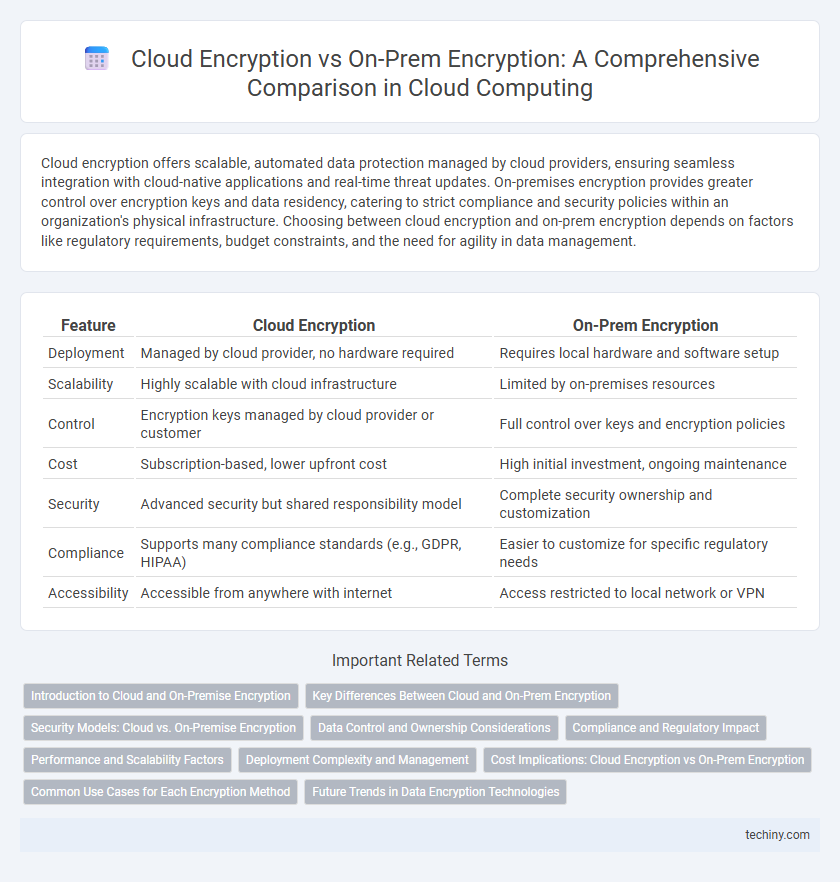Cloud encryption offers scalable, automated data protection managed by cloud providers, ensuring seamless integration with cloud-native applications and real-time threat updates. On-premises encryption provides greater control over encryption keys and data residency, catering to strict compliance and security policies within an organization's physical infrastructure. Choosing between cloud encryption and on-prem encryption depends on factors like regulatory requirements, budget constraints, and the need for agility in data management.
Table of Comparison
| Feature | Cloud Encryption | On-Prem Encryption |
|---|---|---|
| Deployment | Managed by cloud provider, no hardware required | Requires local hardware and software setup |
| Scalability | Highly scalable with cloud infrastructure | Limited by on-premises resources |
| Control | Encryption keys managed by cloud provider or customer | Full control over keys and encryption policies |
| Cost | Subscription-based, lower upfront cost | High initial investment, ongoing maintenance |
| Security | Advanced security but shared responsibility model | Complete security ownership and customization |
| Compliance | Supports many compliance standards (e.g., GDPR, HIPAA) | Easier to customize for specific regulatory needs |
| Accessibility | Accessible from anywhere with internet | Access restricted to local network or VPN |
Introduction to Cloud and On-Premise Encryption
Cloud encryption secures data stored in remote cloud servers by using advanced algorithms, ensuring protection against unauthorized access and cyber threats. On-premise encryption involves safeguarding data within local infrastructure, offering greater control but requiring significant resources for maintenance and updates. Both methods use key management systems, but cloud encryption often benefits from automated scalability and integrated security features.
Key Differences Between Cloud and On-Prem Encryption
Cloud encryption leverages distributed key management and automated scalability to secure data across multiple geographic locations, enhancing flexibility and accessibility. On-prem encryption requires dedicated hardware and manual key management, offering greater control but limited scalability and higher infrastructure costs. Cloud encryption supports dynamic access policies and integration with advanced threat detection, whereas on-prem solutions often face challenges in implementing such rapid updates and broad visibility.
Security Models: Cloud vs. On-Premise Encryption
Cloud encryption leverages distributed key management and multi-tenant architecture, enhancing scalability and enabling seamless data protection across global infrastructures. On-premise encryption relies on localized hardware security modules (HSMs) and direct administrative control, providing strict data residency and reduced latency but requiring substantial maintenance. Cloud security models emphasize automated compliance and dynamic threat detection, while on-premise solutions prioritize physical security and customizable encryption protocols tailored to specific organizational policies.
Data Control and Ownership Considerations
Cloud encryption often involves third-party service providers managing encryption keys, which can raise concerns about data control and ownership due to shared infrastructure. In contrast, on-premises encryption grants organizations full ownership and direct control over encryption keys and data access, enhancing security customization. Data sovereignty regulations also influence the choice, as on-prem encryption ensures compliance by keeping sensitive information within organizational boundaries.
Compliance and Regulatory Impact
Cloud encryption offers dynamic compliance benefits by aligning with evolving regulatory standards such as GDPR, HIPAA, and PCI DSS through automated updates and centralized key management. On-premises encryption provides granular control over data residency and access, critical for organizations facing strict industry regulations or regional data sovereignty laws. Choosing between cloud and on-prem encryption affects the ease of audit readiness, liability sharing, and the complexity of meeting compliance mandates in highly regulated sectors.
Performance and Scalability Factors
Cloud encryption leverages distributed architectures and elastic resources to deliver superior performance and scalability compared to on-premises encryption, enabling rapid data processing and dynamic workload adaptation. On-prem encryption often faces hardware limitations and fixed resource capacities that can hinder scaling efforts and impact performance under high demand. Cloud environments optimize encryption throughput using advanced hardware acceleration, automated key management, and scalable infrastructure, ensuring seamless expansion with minimal latency.
Deployment Complexity and Management
Cloud encryption offers simplified deployment through automated key management and integrated security policies within cloud platforms, reducing the need for extensive hardware setup. On-prem encryption requires complex configuration of physical devices, manual key distribution, and continuous oversight by dedicated IT staff to maintain encryption integrity. Management in cloud environments benefits from centralized control dashboards and real-time analytics, while on-premises solutions often involve fragmented tools and labor-intensive monitoring processes.
Cost Implications: Cloud Encryption vs On-Prem Encryption
Cloud encryption typically lowers upfront capital expenses by eliminating the need for physical hardware and maintenance, shifting costs to a predictable subscription model. In contrast, on-prem encryption demands significant initial investment in infrastructure, ongoing operational costs, and dedicated IT personnel. Organizations must evaluate scalability, total cost of ownership, and compliance requirements when comparing cloud versus on-prem encryption solutions.
Common Use Cases for Each Encryption Method
Cloud encryption commonly secures data in transit and at rest within hybrid or multi-cloud environments, ensuring protection for SaaS applications, cloud backups, and disaster recovery solutions. On-prem encryption is typically deployed for sensitive data control in regulated industries, such as healthcare or finance, where strict compliance and data sovereignty are crucial. Enterprise organizations often combine both methods to maintain robust security across diverse infrastructure landscapes.
Future Trends in Data Encryption Technologies
Cloud encryption leverages advanced algorithms and scalable infrastructure to provide dynamic security solutions that adapt to growing data volumes and evolving threat landscapes. On-prem encryption remains critical for regulatory compliance and sensitive data control, but innovations like homomorphic encryption and quantum-resistant algorithms are increasingly integrated within cloud environments to future-proof data protection. Emerging trends emphasize decentralization, AI-driven encryption management, and seamless multi-cloud interoperability to enhance encryption effectiveness and operational agility.
Cloud Encryption vs On-Prem Encryption Infographic

 techiny.com
techiny.com